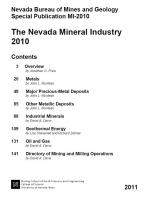Добрый день, Коллеги. Важное сообщение, просьба принять участие. Музей Ферсмана ищет помощь для реставрационных работ в помещении. Подробности по ссылке
Nevada bureau of mines and geology special pubication MI-2010. The Nevada mineral industry 2010
This report highlights activities through 2010 in metals, industrial minerals, geothermal energy, and petroleum. Numerous graphs and charts are incorporated for rapid inspection of trends in production and price. The value of overall mineral and energy production in Nevada increased to an all-time high of $7.72 billion, up substantially from the previous high of $6.26 billion in 2008. Gold production experienced an increase to 5.3 million ounces in 2010, after more or less steadily decreasing from a high of 8.86 million ounces in 1998 to 5.0 million ounces in 2009. 2010 was the 22nd consecutive year with production in excess of 5.0 million ounces. Nevada led the nation in the production of gold, barite, and gypsum, and was the only state that produced magnesite, lithium, and the specialty clays, sepiolite and saponite. Other commodities mined and produced in Nevada in 2010, more or less in order of value, included copper, construction aggregate (sand, gravel, and crushed stone, including limestone and dolomite), silver, geothermal energy, petroleum, lime (produced from limestone and dolomite), cement (produced from limestone, clay, gypsum, and iron ore), silica (industrial sand), diatomite, clays, molybdenum, perlite, iron ore, dimension stone, salt, semiprecious gemstones (turquoise and opal), and mercury (as a byproduct of gold and silver processing). Locations of many of the sites mentioned in the text of this report are shown on NBMG map E-49, Nevada Active Mines and Energy Producers, which is available at www.nbmg.unr.edu/dox/e49.pdf.
As was the case in 2009, Nevada ranked first in the United States in terms of value of overall nonfuel (excluding oil, gas, coal, uranium, and geothermal) mineral production in 2010 (according to the U.S. Geological Survey, Mineral Commodity Summaries http://minerals.usgs.gov/minerals/pubs/mcs/2011/mcs2011.pdf). Arizona, the country’s major copper producer, retained second place. Utah, a major producer of copper and molybdenum, primarily from one mine near Salt Lake City, was third. Minnesota, the leading iron producer in the U.S., was fourth. Alaska, a significant producer of zinc, silver, and gold, was fifth. California, with its large population and commensurate demands for construction raw materials, dropped to sixth, because of the downturn in the housing market. Texas, another populous state and major producer of construction raw materials, was seventh.
Nevada's production of gold, valued at $6.5 billion, was 73% of the U.S. total and helped make the U.S. the third leading gold producer in the world in 2010. Nevada alone accounted for 7% of world production of gold. China, Australia, South Africa, Russia, and Peru each produced more gold than the state of Nevada in 2010. Second to gold in terms of Nevada's mineral value in 2010 was copper ($438 million), followed by construction aggregate ($193 million). Silver, chiefly a byproduct or co-product of gold production, ranked as the fourth leading mineral commodity in 2010, with a value of $149 million. Electrical power from geothermal energy production in Nevada in 2010 was valued at $145 million; its 31% increase in value resulted from an increase in production (23%) and price.




